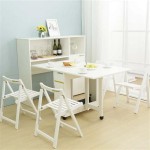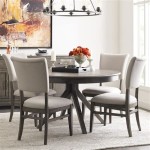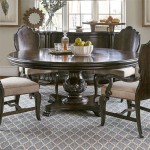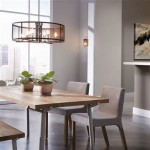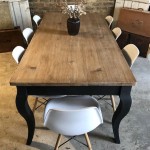Dining Table and Chairs Painted: A Comprehensive Guide
Painting a dining table and chairs is a viable option for updating the look of a dining space without investing in entirely new furniture. This process allows for customization and can breathe new life into older, worn pieces. The success of a painted dining set hinges on proper preparation, the selection of appropriate materials, and the application of suitable painting techniques. This article provides a comprehensive guide to painting dining tables and chairs, covering essential aspects from initial assessment to final finishing.
The decision to paint a dining table and chairs often stems from a desire to change the aesthetic of the dining area. Existing furniture might be structurally sound but visually outdated, exhibiting colors or finishes that no longer align with the overall design scheme. Painting offers a cost-effective solution to align the dining set with current preferences or to introduce a fresh, personalized style. Furthermore, it presents an opportunity to address surface imperfections, such as scratches, dents, or watermarks, thereby restoring the furniture's appearance and extending its lifespan.
Considerations prior to commencing the painting process are essential. The type of wood, the existing finish, and the complexity of the chair design all influence the necessary preparation and painting techniques. A thorough assessment of these factors will guide the selection of appropriate primers, paints, and tools, ultimately impacting the durability and aesthetic appeal of the finished product.
Preparation: The Foundation for a Successful Paint Job
Proper preparation is arguably the most critical stage in painting dining table and chairs. This phase ensures optimal paint adhesion and a smooth, even finish. The initial step involves cleaning the furniture thoroughly to remove dirt, grease, and other contaminants. A solution of mild detergent and water, applied with a soft cloth or sponge, is typically sufficient. For stubborn stains or grease buildup, a stronger degreaser might be required. It is important to allow the furniture to dry completely before proceeding to the next step.
Following cleaning, sanding is necessary to create a slightly textured surface that will allow the primer to adhere properly. The grit of sandpaper used will depend on the existing finish. For glossy or varnished surfaces, a coarser grit (e.g., 120-grit) might be necessary to break down the existing finish. For surfaces with minimal finish or only minor imperfections, a finer grit (e.g., 220-grit) will suffice. Sanding should be performed evenly, following the grain of the wood where possible. Dust generated during sanding should be removed with a tack cloth or a vacuum cleaner with a brush attachment. Leaving any dust behind will result in an uneven finish.
Repairing any imperfections, such as dents or scratches, should be addressed before priming. Wood filler or putty can be used to fill these imperfections. Once the filler is dry, it should be sanded smooth to blend seamlessly with the surrounding surface. Multiple applications of filler might be necessary to achieve a perfectly flush surface. Ensuring a smooth and even surface prior to priming will contribute significantly to the final appearance of the painted dining set.
Finally, masking off areas that are not to be painted, such as decorative hardware or adjacent surfaces, is crucial. Painter's tape should be applied carefully and firmly to ensure a clean, crisp line. Removing the hardware entirely, if feasible, is often the best approach to avoid any paint mishaps. Careful masking demonstrates attention to detail and minimizes the risk of unwanted paint splatters or bleeding.
Selecting the Right Materials: Paint, Primer, and Tools
The selection of appropriate materials is paramount to achieving a durable and aesthetically pleasing finish on painted dining table and chairs. This includes choosing the right primer, paint, and tools.
Primer serves as a crucial bonding agent between the prepared surface and the paint. It promotes adhesion, prevents the paint from being absorbed into the wood, and helps to create a uniform color. Oil-based primers are generally recommended for bare wood or surfaces with existing oil-based finishes. They offer excellent adhesion and stain-blocking properties. Latex primers are suitable for previously painted surfaces or over water-based finishes. They are easier to clean up and have lower VOC (volatile organic compound) emissions. Applying two thin coats of primer is generally preferable to one thick coat, as it minimizes the risk of drips and provides better coverage.
The choice of paint depends on the desired aesthetic, durability requirements, and personal preferences. Latex paints are popular for their ease of application, durability, and wide range of colors. They are also water-based, making them easier to clean up. Oil-based paints offer superior durability and a richer, more lustrous finish. However, they require mineral spirits for cleanup and have higher VOC emissions. Chalk paints are a popular option for creating a distressed or antique look. They adhere well to most surfaces with minimal preparation and can be easily sanded or distressed after application. Milk paints offer a similar matte finish but are typically more durable than chalk paints. Several coats of paint are usually necessary to achieve full coverage and a uniform color.
The tools used for painting also play a significant role in the final outcome. High-quality paintbrushes are essential for achieving a smooth, even finish. Natural bristle brushes are recommended for oil-based paints, while synthetic bristle brushes are better suited for latex paints. Foam rollers can be used for larger, flat surfaces to minimize brushstrokes. Proper brush care, including cleaning after each use and storing them properly, will extend their lifespan and ensure consistent performance. A paint sprayer can be used to achieve a flawless, professional-looking finish. However, it requires practice and careful setup to avoid drips, runs, and overspray. Ensure proper ventilation when using a paint sprayer.
Beyond these primary materials, sandpaper, tack cloths, painter's tape, drop cloths, and stirring sticks are also essential for a successful painting project. The use of appropriate safety gear, such as gloves and a respirator, is crucial to protect oneself from harmful fumes and dust particles.
Painting Techniques: Achieving a Flawless Finish
Mastering the painting techniques is essential in achieving a flawless finish on a dining table and chairs. The application method significantly impacts the final appearance and durability of the painted surface.
Before starting to paint, ensure that the paint is thoroughly mixed to distribute the pigments evenly. Dipping the brush or roller too deeply into the paint can lead to drips and runs. Instead, load the brush or roller moderately, tapping off any excess paint. Applying the paint in thin, even coats is crucial. Avoid applying too much paint at once, as this can result in an uneven finish and increase the drying time. Overlapping each stroke slightly helps to blend the paint seamlessly and prevent streaks.
When painting chairs, pay particular attention to the intricate details and hard-to-reach areas. A smaller brush might be necessary to paint spindles, carvings, and corners. Applying multiple thin coats is better than one thick coat, especially in areas with intricate details. Rotating the chair frequently while painting allows for better access to all surfaces and ensures a consistent finish.
Allow each coat of paint to dry completely before applying the next one. Drying times can vary depending on the type of paint, humidity, and temperature. Following the manufacturer's recommendations for drying times is essential. Lightly sanding between coats with a fine-grit sandpaper (e.g., 320-grit) can help to smooth out any imperfections and create a smoother surface for the next coat of paint. Remember to remove any sanding dust with a tack cloth before applying the next coat.
After the final coat of paint has dried completely, consider applying a clear topcoat to protect the painted surface and enhance its durability. Polyurethane is a popular choice for dining tables and chairs, as it provides a tough, scratch-resistant finish. Wax can also be used to add a subtle sheen and protect the paint. Apply the topcoat in thin, even coats, following the manufacturer's instructions for drying times. Allow the topcoat to cure fully before using the dining table and chairs. This will ensure that the finish is fully hardened and resistant to damage.

How To Save Tired Dining Room Chairs With Chalk Paint Right Now

The Best Way To Paint A Dining Table And Chairs Confessions Of Serial Do It Yourselfer

Brand New Farmhouse 5ft Kitchen Dining Table And 6 Mixed Chairs Painted In Farrow Ball Colours Etsy Canada

My Diy Thrifted Dining Table Chairs Makeover I Spy

Using Milk Paint On Free Dining Room Chairs Recreated Designs

Table And Chairs Makeover With Chalk Style Paint I Should Be Mopping The Floor

Americana Decor Chalky Paint Furniture Makeover

Inspirations Dining Table And Chairs Make Over

Antique Dining Table Updated With Chalk Paint Anderson Grant

Painting A Dining Table And Chairs With Latex Paint


